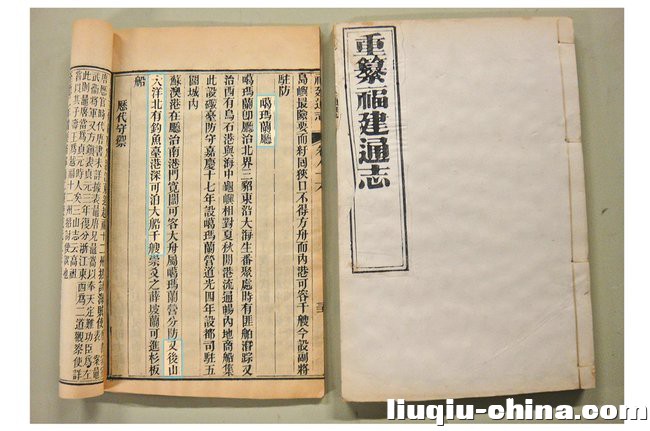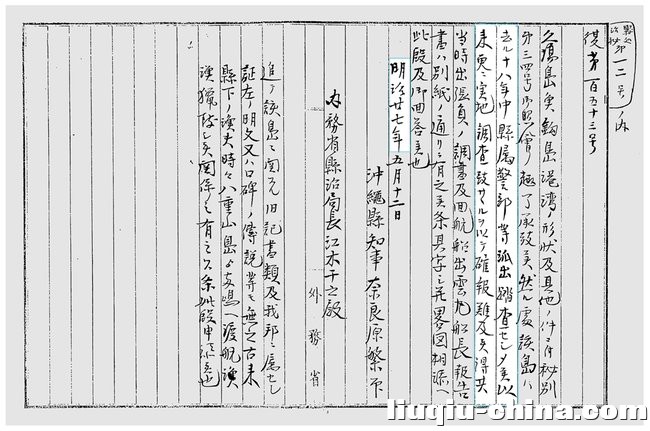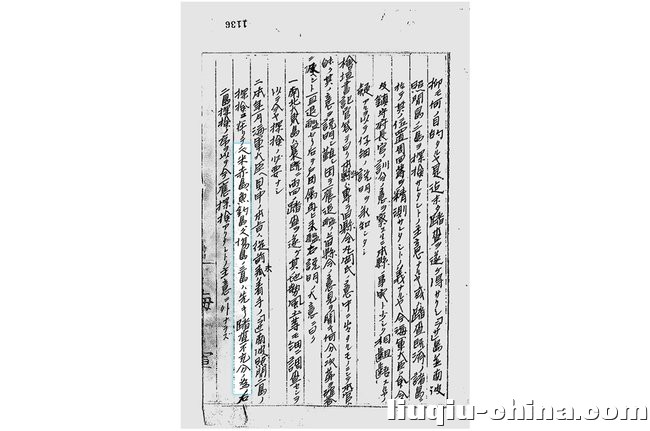| Inconvenient Truth Behind the Diaoyu/Senkaku Islands By HAN-YI SHAW September 28, 2012 I've had a longstanding interest in the Diaoyu/Senkaku islands, the subject of a dangerous territorial dispute between Japan and China. The United States claims to be neutral but in effect is siding with Japan, and we could be drawn in if a war ever arose. Let me clear that I deplore the violence in the recent anti-Japan protests in China: the violence is reprehensible and makes China look like an irrational bully. China's government should rein in this volatile nationalism rather than feed it. This is a dispute that both sides should refer to the International Court of Justice, rather than allow to boil over in the streets. That said, when I look at the underlying question of who has the best claim, I'm sympathetic to China's position. I don't think it is 100 percent clear, partly because China seemed to acquiesce to Japanese sovereignty between 1945 and 1970, but on balance I find the evidence for Chinese sovereignty quite compelling. The most interesting evidence is emerging from old Japanese government documents and suggests that Japan in effect stole the islands from China in 1895 as booty of war. This article by Han-Yi Shaw, a scholar from Taiwan, explores those documents. I invite any Japanese scholars to make the contrary legal case. - Nicholas Kristof Japan's recent purchase of the Diaoyu/Senkaku Islands has predictably reignited tensions amongst China, Japan, and Taiwan. Three months ago, when Niwa Uichiro, the Japanese ambassador to China, warned that Japan's purchase of the islands could spark an "extremely grave crisis" between China and Japan, Tokyo Governor Ishihara Shintaro slammed Niwa as an unqualified ambassador, who "needs to learn more about the history of his own country".  Diaoyu Island is recorded under Kavalan, Taiwan in Revised Gazetteer of Fujian Province (1871). 上图:根据《重纂福建通志》(1871),钓鱼岛属台湾噶玛兰厅管辖。  Japan Diplomatic Records Office. Letter dated May 12, 1894 affirming that the Meiji government did not repeatedly investigate the disputed islands. 上图:1894年5月12日的信札证实,明治政府并没有对这些有争议的岛屿进行再三的实地调查。  Report dated August 12, 1892 from navy commander affirming the islands were not fully investigated. Source: Library of The National Institute for Defense Studies. 上图:日本明治政府当时的海军将领在1892年8月12日的报告证实,对这些岛屿的勘察并未完成。来源:防卫省防卫研究所图书馆。 Ambassador Niwa was forced to apologize for his remarks and was recently replaced. But what is most alarming amid these developments is that despite Japan's democratic and pluralist society, rising nationalist sentiments are sidelining moderate views and preventing rational dialogue. The Japanese government maintains that the Diaoyu/Senkaku Islands are Japanese territory under international law and historical point of view and has repeatedly insisted that no dispute exists. Despite that the rest of the world sees a major dispute, the Japanese government continues to evade important historical facts behind its unlawful incorporation of the islands in 1895. Specifically, the Japanese government asserts, "From 1885 on, our government conducted on-site surveys time and again, which confirmed that the islands were uninhabited and there were no signs of control by the Qing Empire." My research of over 40 official Meiji period documents unearthed from the Japanese National Archives, Diplomatic Records Office, and National Institute for Defense Studies Library clearly demonstrates that the Meiji government acknowledged Chinese ownership of the islands back in 1885. Following the first on-site survey, in 1885, the Japanese foreign minister wrote, "Chinese newspapers have been reporting rumors of our intention of occupying islands belonging to China located next to Taiwan. At this time, if we were to publicly place national markers, this must necessarily invite China's suspicion. " In November 1885, the Okinawa governor confirmed "since this matter is not unrelated to China, if problems do arise I would be in grave repentance for my responsibility". "Surveys of the islands are incomplete" wrote the new Okinawa governor in January of 1892. He requested that a naval ship Kaimon be sent to survey the islands, but ultimately a combination of miscommunication and bad weather made it impossible for the survey to take place. "Ever since the islands were investigated by Okinawa police agencies back in 1885, there have been no subsequent field surveys conducted," the Okinawa governor wrote in 1894. After a number of Chinese defeats in the Sino-Japanese War, a report from Japan's Home Ministry said "this matter involved negotiations with China... but the situation today is greatly different from back then." The Meiji government, following a cabinet decision in early 1895, promptly incorporated the islands. Negotiations with China never took place and this decision was passed during the Sino-Japanese War. It was never made public. In his biography Koga Tatsushiro, the first Japanese citizen to lease the islands from the Meiji government, attributed Japan's possession of the islands to "the gallant military victory of our Imperial forces." Collectively, these official documents leave no doubt that the Meiji government did not base its occupation of the islands following "on-site surveys time and again," but instead annexed them as booty of war. This is the inconvenient truth that the Japanese government has conveniently evaded. Japan asserts that neither Beijing nor Taipei objected to U.S. administration after WWII. That's true, but what Japan does not mention is that neither Beijing nor Taipei were invited as signatories of the San Francisco Peace Treaty in 1951, from which the U.S. derived administrative rights. When Japan annexed the Diaoyu/Senkaku Islands in 1895, it detached them from Taiwan and placed them under Okinawa Prefecture. Moreover, the Japanese name "Senkaku Islands" itself was first introduced in 1900 by academic Kuroiwa Hisashi and adopted by the Japanese government thereafter. Half a century later when Japan returned Taiwan to China, both sides adopted the 1945 administrative arrangement of Taiwan, with the Chinese unaware that the uninhabited "Senkaku Islands" were in fact the former Diaoyu Islands. This explains the belated protest from Taipei and Beijing over U.S. administration of the islands after the war. The Japanese government frequently cites two documents as evidence that China did not consider the islands to be Chinese. The first is an official letter from a Chinese consul in Nagasaki dated May 20, 1920 that listed the islands as Japanese territory. Neither Beijing nor Taipei dispute that the Diaoyu/Senkaku Islands --- along with the entire island of Taiwan --- were formally under Japanese occupation at the time. However, per post-WW II arrangements, Japan was required to surrender territories obtained from aggression and revert them to their pre-1895 legal status. The second piece evidence is a Chinese map from 1958 that excludes the Senkaku Islands from Chinese territory. But the Japanese government's partial unveiling leaves out important information from the map's colophon: "certain national boundaries are based on maps compiled prior to the Second Sino-Japanese War(1937-1945)." Qing period (1644-1911) records substantiate Chinese ownership of the Diaoyu/Senkaku Islands prior to 1895. Envoy documents indicate that the islands reside inside the "border that separates Chinese and foreign lands." And according to Taiwan gazetteers, "Diaoyu Island accommodates ten or more large ships" under the jurisdiction of Kavalan, Taiwan. The right to know is the bedrock of every democracy. The Japanese public deserves to know the other side of the story. It is the politicians who flame public sentiments under the name of national interests who pose the greatest risk, not the islands themselves. Han-Yi Shaw is a Research Fellow at the Research Center for International Legal Studies, Chengchi University, in Taipei, Taiwan. 关于钓鱼岛,日本难以示人的真相 文:邵汉仪, 2012年09月28日 我一直对钓鱼岛/尖阁诸岛很感兴趣,中日两国因为这个群岛而爆发了危险的领土纷争。美国声称持中立态度,但实则支持日本。而且战争一旦爆发,我们很有可能卷入。让我先明确一点,我强烈反对最近中国反日游行中的暴力行为:暴力行为应该受到谴责,这让中国看起来像是个毫无理性的暴徒。中国政府应该遏制这种危险的民族主义,而不是纵容之。中日双方都该把这一争端诉诸联合国国际法院(International Court of Justice),而不是让其在大街上沸腾。话虽如此,但当我分析哪方在此事上持有最充分理由这个基本问题时,我更认同中国的立场。我并不是完全确定,部分原因是因为,中国似乎在1945到1970年之间默认了日本的主权。但总的来说,我发现证明中国拥有主权的依据十分有力。最有趣的证据来自过去的日本政府文件,文件表明,日本实际上是在1895年把这些岛屿作为战利品从中国手里夺走的。台湾学者邵汉仪(Han-Yi Shaw)的文章对这些文件进行了阐述。我诚请任何日本学者提出相反的法律论据。——纪思道(Nicholas Kristof) 日本最近对钓鱼岛/尖阁诸岛的购岛行为,不出意料地再次激发了中国大陆、日本和台湾之间的紧张局势。三个月前,日本驻中国大使丹羽宇一郎(Uichiro Niwa)对于日本购买钓鱼岛一事表示,“将会使日中关系陷入重大危机”,东京都知事石原慎太郎(Shintaro Ishihara)却抨击丹羽宇一郎是不称职的大使,指其“需要更好地学习自己国家的历史”。 丹羽大使被迫为他的言论道歉,并在最近被撤换。但最令人担忧的是,日本尽管是一个民主多元的社会,但日益增长的民族主义情绪,逐渐在压倒温和的观点和阻碍理性的对话。 日本政府坚持认为,根据国际法和历史观点,钓鱼岛/尖阁诸岛为日本领土。日本政府还一再重申“不存在领土争议”。尽管在全世界眼中,确实存在巨大争议,日本政府却依旧逃避1895年非法编入该岛屿背后的重要史实。 日本政府声称,“自一八八五年以来, 日本政府通过冲绳县当局等途径再三对尖阁诸岛进行实地调查, 慎重确认尖阁诸岛不仅为无人岛, 而且没有受到清朝统治的痕迹。” 我从日本国立公文馆(Japanese National Archives)、外务省外交史料馆(Diplomatic Records Office)和防卫省防卫研究所图书馆(National Institute for Defense Studies Library)找到了逾40份明治时期的文件。通过这些文件可知,当时的明治政府充分意识到清朝政府对于钓鱼岛的主权。 1885年第一次实地调查之后,当时的日本外务卿写道,“近时清国报纸揭载我政府欲占据台湾近傍之中国所属岛屿的传闻,对我国抱以疑忌,并促中国政府予以注意。我政府若于此时遽尔公然建立国标,反易招致中国的疑忌。” 1885年11月,冲绳县令表示,“此事与清国不无关系,倘生意外,将不知如何应对,殷盼指示。” “鉴于尚未再次踏查各岛,”新任冲绳县知事在1892年1月写道,因此要求海军派遣军舰海门号(Kaimon)前去勘察。然而由于军令传达不善和天气恶劣,勘测并未实现。 “自1885年由琉球县属警部派出之调查以来,期间未再进行实地调查”冲绳县知事在1894年写道。 中国在甲午战争中屡战屡败,日本内务省的一份文件写道:“此事过去涉及与清国交涉……但今昔情况已殊。”明治政府随即通过1895年初的内阁决议,将这些岛屿据为己有。 日本从未与中国就此事进行交涉,且该决定是在甲午战争期间秘密通过的,从未公之于世。 古贺辰四郎(Tatsushiro Koga)是首位从明治政府手里租赁这些岛屿的民间人士。古贺的传记中把日本对这些岛屿的占有归功于“皇国大捷之结果”。 这些官方文件皆确凿表明,明治政府占有这些岛屿的依据不是“再三的实地调查”,而是将这些岛屿作为战利品吞并。这些难以示人的真相,至今被日本政府刻意回避了。 日本称,北京和台北在二战以后都没有反对美国对琉球群岛的托管统治。这是事实,但日本没有提及的是,北京和台湾都不是1951年《旧金山和平条约》(San Francisco Peace Treaty)的签字国,而美国正是根据该条约获得了对上述地区的管辖权。 日本于1895年通过内阁决议编入钓鱼岛/尖阁诸岛时,将原来为台湾附属岛屿的这些岛屿,划入冲绳县。此外,“尖阁列岛”这一名称是日本学者黑岩恒(Kuroiwa Hisashi)于1900年新设的,随后被日本政府采用。半个世纪后,当日本把台湾归还中国时,中日双方沿用了1945年前日本殖民时期在台湾之行政区划记录。正因如此,中方对于无人岛的“尖阁列岛”,实际就是历史上的钓鱼岛无所知悉。这也说明了台北和北京为何会对于战后美国的托管之事,提出了迟来的抗议。 日本政府经常引用两份文件作为依据,来证明中国未把这些岛屿视为中国领土。第一份文件是中国驻长崎领事在1920年5月20日的感谢状,其中把这些岛屿列为“大日本帝国”的范围内。 实际上,北京和台北都不否认钓鱼岛/尖阁诸岛,连同台湾全岛,在当时皆受到日本的殖民统治。但根据二战后的协议,日本应归还自中国窃取的领土,并且恢复这些领土在1895年之前的法律地位。 第二个依据是1958年的中国地图,上面把尖阁诸岛排除在中国领土之外。但日本政府只展示了地图部分,却未提及版权页的重要说明:“中国部分国界线,根据抗日战争前申报地图绘制。” 清代(1644-1911)的官方记录也证明,钓鱼岛/尖阁诸岛在1895年之前为中国领土。清代册封使录将这些岛屿位于“中外之界”的范围之内。历代的台湾地方志更明确记载:“山后大洋北,钓鱼台港深可泊大船十艘,”属台湾噶玛兰厅管辖。 获知真相的权利是每一个民主国家的基石。日本民众有权知道故事的另一面。毕竟,导致今日最大危机的,是假借国家利益为名,煽动公众情绪的政客们,而不是这些岛屿本身。 邵汉仪,政治大学(台湾)国际法学研究中心研究员。 (Research Fellow, Research Center for Legal Studies, Chengchi University)。 翻译:陶梦萦 |
手机版|小黑屋|Archiver|中国琉球网 ( 闽ICP备13003013号 )
GMT+8, 2024-7-27 17:23 , Processed in 1.690493 second(s), 11 queries , File On.
Powered by Discuz! X3.4
© 2001-2023 Discuz! Team.